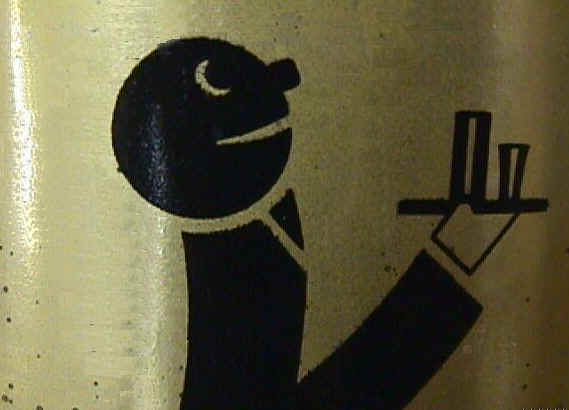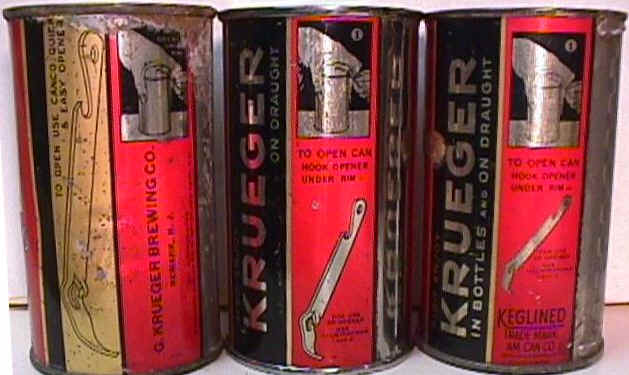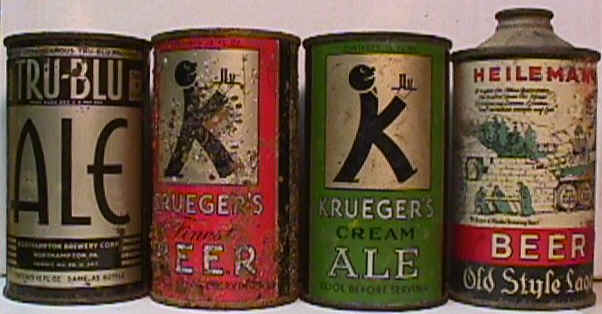

The First Beer Cans
Krueger’s
– The first canned beer
The technology for canning beer existed long before it
actually occurred. Some evidence of experimentation dates back to the late
1910’s. Prohibition (1919-1933) put those efforts on hold. Once Prohibition
for beer was repealed in April of 1933, American Can Company renewed its efforts
to entice brewers to can their product. The first fish to take the bait was not
the biggest. In fact it was a moderately sized brewer in Newark, New Jersey, the
Gottfried Kreuger Brewing Company. The first known production run was in late
1933. The trial run is believed to have been 2000 cans. The cans were never
sold. The design was very similar to later Krueger cans but is distinguished by
different wording on the can. The trial cans were labeled “Krueger’s Special
Beer”. Later can designs changed to Krueger’s Finest Beer and later, Krueger
Finest Beer. The big moment arrived after a favorable initial test. G. Krueger
Brewing must have felt it was a huge gamble to be first out with canned beer. It
was too big a gamble to release the product in their regional market. Instead, a
test market in Richmond, Virginia was established. On January 24, 1935, canned
beer went on sale. Two brands were sold, Krueger’s Finest Beer and Krueger’s
Cream Ale.

Krueger's cans from 1935. The two inside cans are non-tax cans. The tax statement on the two outside cans is at the very bottom of the cans. You can s read a similar story about Krueger at the BCCA website. Click http://www.bcca.com/index.html. The can pictured at that site is a digitally constructed image of the "Special" beer test can.
Now,
how do you open the cans? Food had been available in “tin cans” for several
decades and the traditional method of opening a food can involved removing the
whole lid. This method was not necessary for liquid, nor would it be convenient
outside of a kitchen where can openers were likely to be found. American Can
solved this problem by distributing a beer can opener designed to punch a hole
in the lid. For several years, cans showed a picture of an opener on the side
panel and instructions on how to use it. Can collectors call these cans
“instructionals” or "OI cans". By 1950 these opening instructions
had all but disappeared from beer cans. Cans made until World War II were made
from much heavier steel than later cans. Openers from this era were longer and
stronger in order to pierce the lid easier.
 Krueger
OI Cans.
Krueger
OI Cans.
If
bare steel were used hold beer, the beer would react with the steel and quickly
spoil. Cans had to have an inner lining to prevent spoilage. American Can called
this lining Keglined. Keglined is often explained on early cans. The keglined
symbol continued to appear on some cans into the 1960’s.
Below is Marc Tracy's guide to the sequence of the 5 "baldie" cans.

Cans without tax statements, 1935
All
canned and bottled beer was required to contain a tax statement on the
container. Two statements were used, “Internal Revenue Tax Paid” and “Tax
Paid at the Rate Prescribed by Internal Revenue”. These cans are often
referred to as IRTP cans. It has been reported in various publications that
the tax statement law went into effect on June 1, 1935 (2 other dates in June
and July have also been reported). This is now being challenged by several
people. The theory is that tax statements were required beginning in 1933 with
the repeal of prohibition. Beer bottle labels tend to confirm this. The lack of
tax statements on cans is being attributed to an oversight or misunderstanding
of the laws by the breweries and can companies. Some canned beer from Northampton Brewing (Tru Blu Ale) and G
Heileman (5 variations of Old Style Lager low profile cones) also do not have
tax statements. The following is a list of breweries and dates they are believed
to have obtained canning equipment.
Krueger
1934
Pabst
5-23-35
Northampton
6-11-35
Scheidt
6-27-35
Ballatine
7-25-35
Red Top
8-08-35
Globe
8-12-35
Heileman
8-13-35
Schlitz
8-27-35
I
have checked the accuracy of this story with a few beer historians and can
collectors. If you have any further information or corrections, I would be
pleased to hear from you.

|
|||||||